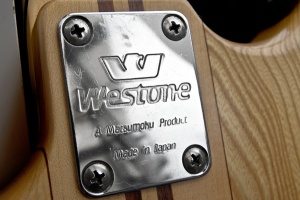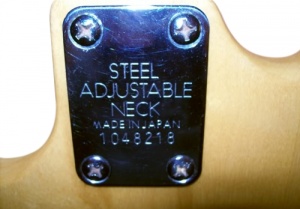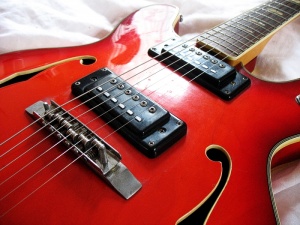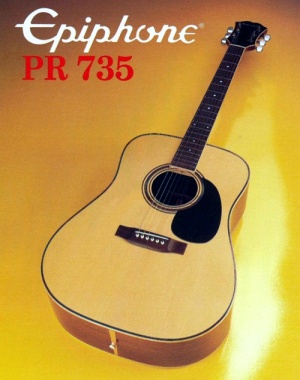Matsumoku Industrial Company
|
This page focuses mainly on Epiphone guitars made at the Matsumoku factory in Japan. For more information pertaining to the Matsumoku factory not relating to Epiphone, click on the "Matsumoku" link to wikipedia below.
MatsumokuMatsumoku Industrial Co. was a Japanese manufacturing company from c. 1900 - 1987. Established around 1900 as a woodworking manufacturer of various items but is best known as a manufacturer of high quality guitars and bass guitars including some Epiphone and Aria guitars. Originally a family woodworking company specializing in tansu storage chests and butsudan shrines, by the mid 1940's, Matsumoku was contracted by the Singer Corporation to produce sewing machine cabinets. By 1951 Matsumoku became a partially owned subsidiary of Singer, Japan. Matsumoku also built amplifier, radio and television cabinets. By the 1960's Matsumoku was producing violins, classical guitars, small steel-string acoustic guitars, as well as venturing in to high quality electric and acoustic archtop guitars. Matsumoku worked mainly as a contractor, producing guitars and parts for companies such as Vox, Greco, Yamaha, Ibanez, Aria and Norlin among others. In 1979 Matsumoku began manufacturing their own guitars under the Westone name. Matsumoku was one of the first guitar companies to use CNC machines in the guitar building process. By 1986, the home sewing machine market was in heavy decline and Singer was nearly bankrupt. Matsumoku could not afford to buy itself out of Singer and in 1987, closed down. Information about Matsumoku's contribution to guitar making is better known now due in large part to the Internet. Matsumoku's products enjoy a strong following among devoted enthusiasts.
Epiphone1969 On December 19, 1969- ECL Industries Inc. ("Ecuadorian Company Limited"-incorporated in Delaware and a U.S. subsidiary of a Panamanian corporation of the same name) officially takes over CMI. Norlin is an amalgamation of the first syllable of ECL's chairman's first name, Norton Stevens and the last syllable of CMI's president M.H. Berlin's last name.
By 1970, ECL's U.S. operation becomes "Norlin Industries Inc." and the Panamanian corporation becomes "Norlin Corporation". CMI remains a subsidiary of the U.S. operation. By ths time, Epiphone had moved production to Japan and chose Aria as its contractor. As a subcontractor to Aria, Matsumoku manufactured all Epiphone guitars until the 1980's. Early Matsumoku Epiphones were considered by most as inferior guitars compared to the earlier USA models. From 1970-1974, most Epiphone guitars came standard with bolt necks, generic parts and mostly unrecognizable body shapes, including archtops and acoustics. These body designs were pre-designed shapes already in use Aria, who also contracted through Matsumoku. The acoustic and archtop models used the familiar blue "Kalamazoo"-type Epiphone interior labels and early models make use of actual left-over Kalamazoo labels bearing the "Union Made" designation. The first year model year nomenclature was carried-over from the Aria models. In 1972 new model designations using the alpha prefixes "FT", "EA" and "ET" were used on these imported Epiphones. Many of the acoustic guitars had screws and a neck plate on the back of the instrument as well, while other models had necks that were screwed in from the interior of the guitar and were mostly undetectable without close inspection.
Norlin opens the Nashville operation producing the higher volume instruments such as the Les Paul models while the Kalamazoo operation, now antiquated, continues making the lower volume models. By 1977 the corporate center of Gibson's universe was Nashville. Epiphone corporate operations are moved to Lincolnwood, Illinois. At about this point Epiphone began using the "Norlin" square label replacing the blue Kalamazoo-type label. The higher-end line of Matsumoku-made Epiphone labels continue to reference "Epiphone/Kalamazoo" During this time, Epiphone began producing higher quality instruments strictly for the Japanese market. These guitars were more akin to older Epiphone models and were of superior quality than the models made for export and incuded set-necks, a design not seen in previous Matsumoku-made Epiphones. Some of these models included the Wilshire, Emperor, Riviera, Casino and Newport bass. Though more similar to original Epiphone designs than previous Matsumoku Epiphones, these higher quality domestic instruments still had much variation from their predecessors. Archtop body shapes were familiar, but not exact. Inlays and appointments were different and varied, and the hardware was still mostly generic, yet of higher specifications than previous years. In June, 1979, Norlin merges Gibson Inc. into Norlin Industries Inc. and Gibson ceases to exist as a manufacturing operation becoming only a brand name as Epiphone had previously become.
1980 1980 saw world-wide distribution for many of these models along with a few minor redesigns. The Casino, Riviera and Sheraton, among other models, were now available outside of Japan. However, some models, like the Wilshire and Newport, were never released outside of the Japanese market. As the quality of these instuments was considerably higher than previous Matsumoku Epiphones, today they are highly regarded and sought after, demanding signifigantly higher resale prices than previous Japanese Epiphones. In 1983, most Epiphone guitar production is moved to Korea and contracted out to Samick. Matsumoku continued to make the higher-end line of Epiphone instruments in Japan until 1987 when Matsumoku ceased operations. Some Epiphone instruments at this point in time are also made in Taiwan and Indonesia.
In 1986, Henry Juszkiewicz, David Berryman and Gary Zebrowski bought Gibson/Epiphone from Norlin and moved the major part of production to Samick, leaving a a few archtop models to be made in Japan as higher-end versions of instruments that were also being produced in Korea. Though production continued for some Epiphone models in Japan, Matsumoku had went out of business by 1987 and the remaining Japanese production was moved to the Terada and FujiGen factories. Epiphone continued to produce Japanese-made archtop guitars for export until 1994, when, under new contract, all Japanese built Epiphones were once again produced for the Japanese Domestic Market only. At this point, production included archtops as well as acoustics, solid body guitars and basses. This lasted until 2006 to various degrees until the launch of the Elite/Elitist series which included exports and domestic versions of the same instruments with slight variations, most notably the headstock shape. |
Electrics | Archtops | Acoustics | Basses | Bluegrass | Amplifiers | Promotional Guitars



